Origin of the Phrase ‘Hitting for the Cycle’ and An Approach to How Cycles Occur
This article was written by Allison Davidson - Mike Huber
This article was published in Spring 2018 Baseball Research Journal
One of the most exciting accomplishments in major league baseball is exciting because of its rarity. When a batter hits for the cycle, he gets a single, double, triple, and home run in the same game. From 1876 through the end of the 2017 regular season, there have been only 319 instances of a batter accomplishing this feat.1 Given that there have been 214,651 games played, hitting for the cycle is indeed a rare event, as it has occurred in fewer than 1% of all games (0.149%, to be more precise).2 To date, no game has seen more than one batter hit for the cycle.
The purpose of this paper is twofold. First, we will provide evidence of when the phrase hitting for the cycle was popularized by the media to describe the feat, and how the phrase evolved to what we use today. Throughout the paper, we will use bold font to indicate the actual cycle descriptors found in the newspapers of the day. Not until the 70th occurrence of a cycle did someone in the media try to characterize the four different hits with a common label, and more than 20 additional occurrences took place before the characterization was popularized as “hitting for the cycle” and used throughout the country. Second, we will provide descriptive statistics on the event itself and how attaining the cycle has changed over time. In recent seasons, the order in which a batter is most likely to attain a cycle has changed, especially in regards to the final hit. For example, is the last hit of a cycle most likely a triple? Has it always been that way?
The First Cycle
Charles “Curry” Foley became the first batter to hit for the cycle on May 25, 1882, hitting a bases-loaded home run in the first inning, a triple in the second, a double in the fifth, and a single in the seventh. Foley had 10 total bases in six at-bats, and his cycle occurred in reverse natural order. A natural cycle indicates that the hits are in order of total bases with single first, then double, triple, and home run. A reverse natural cycle indicates the opposite order. Buffalo blasted the Cleveland Blues, 20-1, of which four runs were scored by Foley.3 He was clearly the hero for the Buffalo Bisons on this day, however the daily newspapers described Foley’s accomplishment without much fanfare.
Some sources (including Retrosheet and Baseball-Reference.com) list that George Hall is actually the first person to hit for the cycle, in a game on June 14, 1876. Michael Huber, an author of this paper, discovered an entry on Baseball-Reference.com and then researched the game in several newspaper accounts. Hall, playing for the Athletic Club of Philadelphia, did get five hits in the contest against the Cincinnati Red Stockings, and all newspapers sources agree that he had a single, a home run, and at least two triples. However, the Philadelphia Times (the hometown paper) reported that Hall also had a double, thus meeting the definition of a cycle, while the New York Clipper and the Cincinnati Enquirer each reported three triples and no double (see Note 1). In Huber’s summary of the game, he cites SABR author Matt Albertson, who writes that John Thorn, the official Historian of Major League Baseball, does not believe that Hall hit for the cycle. Therefore, as this cycle is in dispute, we do not include it in our study. Foley’s performance is clear: four different type hits in the same game.
Since Foley’s cycle in 1882, there have been 318 additional cycles through 2017. A frequency chart, by season, of the number of times a batter has hit for the cycle is shown in Figure 1. There have been two seasons—1933 and 2009—where eight cycles occurred, each by a different batter. There have been many seasons where no batter hit for the cycle.
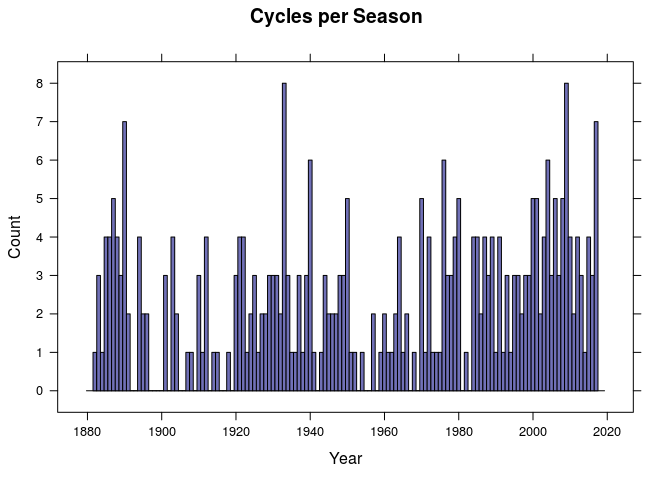
Figure 1: Frequency distribution of cycles, 1882-2017
As another way to view the data, we will show the distribution by era. The website NetShrine.com divides professional baseball into seven eras: 19th Century Era (1876–1900), Dead Ball Era (1901–19), Lively Ball Era (1920–41), Integration Era (1942–60), Expansion Era (1961–76), Free Agency Era (1977–93), and Long Ball Era (1994–2005).4 We extend this last group to 2017, to include the current games. The distribution of cycles by era is shown in Figure 2.

Figure 2: Frequency distribution of cycles by era
Figure 2 shows the number of cycles increased drastically during the Lively Ball Era. In fact, every season in the Lively Ball Era produced at least one cycle. As not every era has the same number of games played, Figure 3 displays the number of cycles per 1000 games by decade. As was seen in the increase in the number of cycles during the Lively Ball Era (1920s and 1930s), the rate of attaining a cycle drastically increased in the 1920s and 1930s as well. It is perhaps because of this explosion of cycles that writers began penning different phrases to describe the event, settling on the term cycle in the early 1930s, the middle portion of the Lively Ball Era.
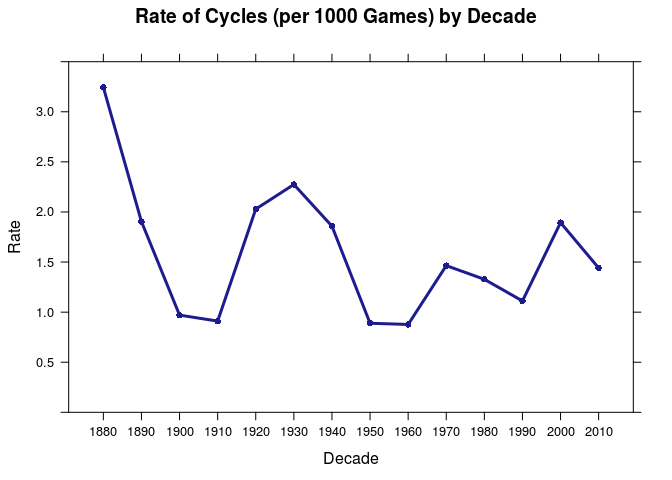
Figure 3: Rate of Cycles (per 1000 games) by Decade
“Hitting for the Cycle”
According to The Dickson Baseball Dictionary, the first printed use of hit for the cycle was in 1933.5 The Washington Post described Philadelphia’s Jimmie Foxx’s accomplishment of August 14, 1933, with, “[Jimmie Foxx] is one of only six players in all major league history to ‘hit for the cycle,’ that is, get a single, double, triple and homer in four times at bat in one game.”6 That article appeared on September 27, 1933. The other five players were not listed in the article.
However, the word cycle was actually used in context twelve years earlier! In the August 21, 1921, edition of the Tennessean, it was reported that George Sisler “hit the cycle” (see Figure 4).7

Figure 4: Mention of cycle in The Tennessean, August 21, 1921
We found no mention of the word cycle for another ten years. Then, on May 18, 1931, Brooklyn Robins batter Babe Herman had four different hits in a home game at Ebbets Field against Cincinnati. This was Herman’s first of two cycles of the season (the other coming on July 24 against Pittsburgh at Forbes Field) and of three in his career. An Associated Press (AP) story dated May 18, 1931 (Figure 5), printed in the Reading Times (Reading, PA) became the just the second citation of the word cycle praising a batter’s collection of the four hits.8

Figure 5: Headline and story in Reading Times, May 18, 1931
Herman had indeed “found his batting eye in a big way.”9 The AP story did not use the entire phrase hit for the cycle, and the word cycle was only used in the headline, but this is only the second time in ten years the four different hits were labeled in what we note today as a cycle. The July 25 papers describing Herman’s prowess did not use the word cycle.
Although Herman was praised for his baseball feat, not all players with the same accomplishment received similar accolades. During the next season, on June 3, 1932, Tony Lazzeri of the New York Yankees hit a single, double, triple, and home run (as well as another single before the home run, and the homer was with the bases loaded) against the Philadelphia Athletics, in a 20-13 shoot-out New York win. Lazzeri’s rare feat had practically no mention to be found in print, as it occurred in the same game where teammate Lou Gehrig tied a record by belting four home runs. There was no mention of a cycle.10 (Curiously, Gehrig didn’t earn much press either, as more than half of the New York Times’ sport section’s front page was devoted to Giants’ manager John McGraw announcing his retirement.)
A month later on July 22, 1932, Mickey Cochrane of the Philadelphia Athletics collected the four necessary hits against Washington. Running an AP story of the game (Figure 6), the Great Falls Tribune (Great Falls, MT) used the following headline: “Mickey Cochrane Gets Four Hits of Different Lengths and Is Game’s Star.”11
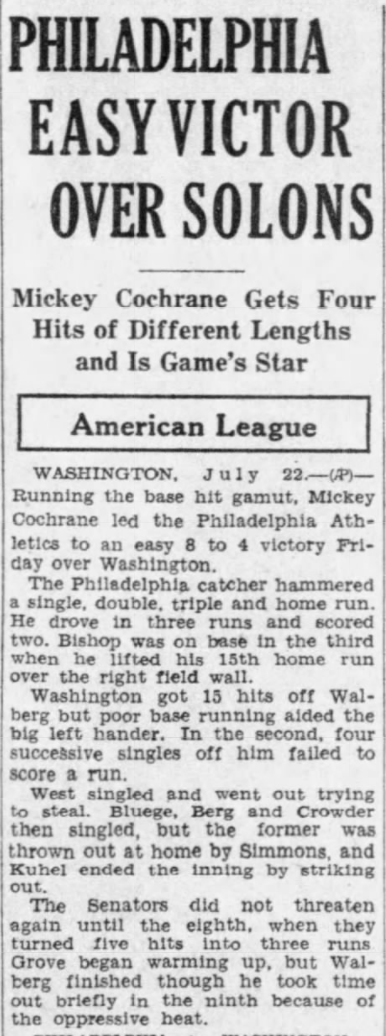
Figure 6: Headline in Great Falls Tribune, July 23, 1932
The Tennessean (Nashville, TN) ran the same AP story under a different headline (see Figure 7): “Cochrane Hits a ‘Circle’ as A’s Crush Senators.”12

Figure 7: Headline in The Tennessean, July 23, 1932
The AP story started with, “Running the base hit gamut, Mickey Cochrane led the Philadelphia Athletics to an easy 8 to 4 victory today over Washington. The Philadelphia catcher hammered a single, double, triple and home run.”13 Notice how the two papers used circle and hits of different lengths to link the type of hit with the number of total bases for the hit. Further, the story’s use of gamut gave the reader the impression that Cochrane had made every kind of hit possible.
A record eight different major-league batters hit for the cycle in 1933.14 The first five (the St. Louis Cardinals’ Pepper Martin on May 5 against the Philadelphia Phillies, the Phillies’ Chuck Klein on May 26 against St. Louis, the Pittsburgh Pirates’ Arky Vaughan on June 24 against the Brooklyn Dodgers, the Philadelphia Athletics’ Mickey Cochrane on August 2 against the New York Yankees, and the Athletics’ Pinky Higgins on August 6 against the Washington Nationals, colloquially known as the Senators) received praise for their many hits, but no mention of a cycle appeared in newspaper print. Then came Foxx and Averill.
Foxx’s rare feat took place on August 14, 1933, but the citation from The Washington Post did not appear in print until September 27. The day after Foxx’s achievement against the Cleveland Indians, the Reading Times revived the term and printed the following headline in their account of the A’s–Indians game (see Figure 8): “Foxx Wallops Cycle to Drive In Nine Runs as A’s Win 11-5.”15
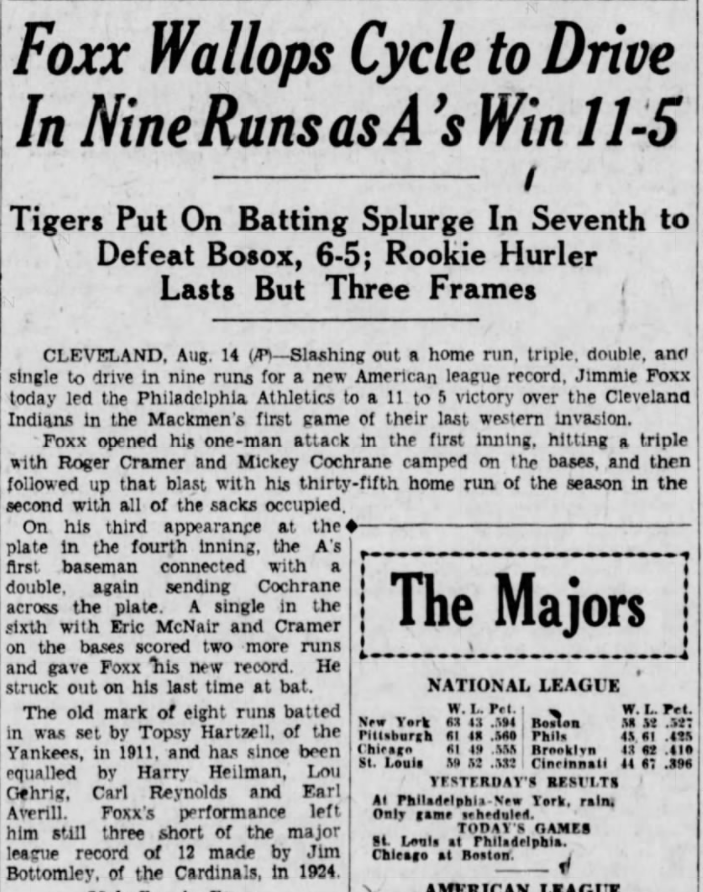
Figure 8: Headline in Reading Times, August 15, 1933
The word cycle again appears only in the headline and not in the story.
The use of the word cycle continued when two days after this headline, on August 17, 1933, Cleveland’s Earl Averill also hit a single, double, triple, and home run in a game against Foxx’s Athletics. On August 18, four different newspapers used cycle in their accounts of that game. “Earl Averill achieved a cycle of hits when he birched the ball for a single, double, triple and home run to top the winning forces.”16 The author of this article for the Philadelphia Inquirer, James C. Isaminger, was also the editor of the Reach Official American League Guide, yet his guides did not use the term hitting for the cycle until after the Reach Guide merged with the Spalding Guide in the mid-1930s. The News-Journal (Mansfield, OH) posted the headline, “Averill Hits For Cycle: Pounds Out Home Run, Triple, Double, and Single to Lead Indians to Win Over Athletics, 15 to 4” as part of a United Press (UP) story.17 And in the Des Moines Register, “Averill’s stickwork completed the cycle, a single, a double, a triple and a home run.”18 Finally, The Sporting News reported, “Earl Averill, Cleveland, completes cycle in hitting single, double, triple and home run.”19
The final cycle of the 1933 season was hit by the Chicago Cubs’ Babe Herman on September 30 against St. Louis. The next day, fans read (although not in the Chicago Tribune) that “Babe Herman did a big day’s work to help the Cubs in their drive down the stretch. He contributed a cycle of safeties, a single, double, triple and home run, and blasted four runs across the plate.”20 Herman became the third batter to ever hit for the cycle three times, and he is the only one of the three whose heroics were described with the word cycle. To date, Babe Herman is one of four players that have hit for the cycle three times in their careers. The others are John Reilly, Bob Meusel, and Adrian Beltre.
In early 1934, The Sporting News listed highlights of the 1933 season stating, “The hitting for a cycle (single, double, triple and home run) by four American League players, Foxx, Cochrane, Averill and Higgins.”21 There was no similar column in this issue for the National League.
Although the label was gaining recognition, it did take a few seasons until hit for the cycle was generally used. In 1934, Doc Cramer of the Philadelphia Athletics hit for the cycle against the New York Yankees on June 10. James C. Isaminger wrote in the Philadelphia Inquirer, “Moreover, the Jersey man made what is known in baseball as a cycle of hits. He hit a single, double, triple, and a home run, every one as clean as a shirt from the laundry.”22 Isaminger hints that this phrase had now become somewhat commonplace. Later in the same season, Lou Gehrig (New York Yankees, June 25) and Moose Solters (Boston Red Sox, August 19) both hit for the cycle but the papers did not mention the word cycle.
Black’s Annual Baseball Schedule and Sport Information was advertised in The Sporting News, on April 18, 1935, with “Hit for a Cycle” as part of the contents.23 There is no mention of the cycle occurrence in Black’s 1934 guide.

Figure 9: Advertisement in The Sporting News, April 18, 1935
Various descriptions were still employed for the next few years. On June 29, 1935, Ducky Medwick of the St. Louis Cardinals hit for the cycle against the Cincinnati Reds. J. Roy Stockton of the St. Louis Post-Dispatch wrote, “Medwick gets cycle of hits. Joe Medwick, who has done much to keep the Cardinals as high as they are, hit a cycle of safeties, a single, double, triple, and home run, driving in three of the St. Louis tallies.”24
The next season, the sole occurrence belonged to New York Giants’ Sam Leslie, who did so against the Philadelphia Phillies on May 24, 1936. The Pittsburgh Post-Gazette printed the following as a description: “Leslie vied with his American League contemporaries by getting five hits out of five times at bat, including the complete album of hits, a homer, a triple, a double, and two singles.”25
It appears as if the phrase had become more widely used by 1937. When Detroit’s Gee Walker cycled against the Cleveland Indians on Opening Day, April 20, 1937, W.W. Edgar of the Detroit Free Press penned, “Of course, [pitcher Elden Auker] got a lot of help from his supporting cast, especially ‘Gee’ Walker, the Reconstructed Rebel, who hit for the cycle with a home run, a triple, a two-base hit, and a single for a perfect day at the plate.”26
Yet three months later, a new phrase was introduced to describe the quartet of hits. The Daily Journal (Vineland, NJ) printed the headline “Yankees’ Slugger In Rare Feat” after Yankees sensation Joe DiMaggio hit for the cycle on July 9, 1937. In the AP story, readers found that “Joe DiMaggio collected a ‘grand slam,’ or every type of base hit, yesterday afternoon, as the New York Yankees drubbed Washington, 16-2, in the opener of a three-game series at Yankee Stadium.”27 This was a unique way to characterize a cycle. When DiMaggio’s teammate Lou Gehrig hit for the cycle on August 1, 1937, for the second time in his career, the newspapers wrote the following:
- “Gehrig led the assault on Lou Koupal and his two successors by hitting for the cycle, getting a triple, double, and single, in addition to his homer, and driving in three runs.”28
- “The Yanks got 17 hits, Lou Gehrig hitting for a ‘cycle’–home run, triple, double and single.”29
- “Gehrig Leads Assault With ‘Cycle’ Hits” (headline). “Gehrig led the assault on Lou Koupal and his two successors by hitting for the cycle, getting a triple, double, and single, in addition to his homer, and driving in three runs.”30
By 1938, it seems that the phrase to describe this rare event was indeed commonplace. In The Sporting News, the following were mentioned from 1938 to 1941:
- “Lloyd James Waner … had distinction this season of hitting for the cycle against Brooklyn.”31
- “Sam Chapman, the ex-California collegian, returned to the line-up and hit for the cycle, collecting a single, double, triple and home run, all blows being as clean as the Duke of Windsor’s shirt front.”32
- “July 13: Johnny Mize hits for cycle, making twenty-second home run, in first game, as Cardinals drive in winning runs in ninth inning of each contest to sweep double-header from Giants.”33
- “The third triumph against Cleveland saw Buddy Rosar hit for the cycle. Only 17 times in the history of the American League had this feat been accomplished.”34
- “Joe [Cronin] hit for the cycle–a homer, triple, double and single–and inasmuch as the triple and double were hit off Buck Newsom, the day was complete for Joe.”35
- “Just a week after his marriage, Buddy [Rosar] hit Al Milnar of the Indians for a home run with the bases full, and the next day, also batting against the Indians, he hit for the cycle–a single, a double, a triple and a homer. ‘I got an especial kick hitting for that cycle,’ added Buddy. ‘I am only the eighteenth American League player to accomplish the feat, and the fourth Yankee, the others being Lou Gehrig, Bob Meusel and Joe DiMaggio. It puts me in the records with some pretty good people, Sisler, Cochrane, Foxx, Averill, to say nothing of those three famous Yankees.’”36
This last entry shows that even the players now knew the importance of the phrase, hitting for the cycle, even though Rosar’s cycle was the 121st in Major League history. From this time forward, it seems that each event of a batter getting the four hits was described as hitting for the cycle. Further, batters today who achieved the rare feat of hitting for the cycle seem to be just as excited as Rosar was.
In summary, The Dickson Baseball Dictionary is not inaccurate in claiming the first use of hit for the cycle in the Washington Post article. The 1921 Tennessean should be given credit for first use, as it reported that Sisler “hit the cycle.” However, the phrase “hitting for the cycle” became popular in the national media more than ten years later, in the early-to-mid 1930s.
Probabilities
Does the order matter? While it may not appear that the order of hits in a given cycle is important, we offer the following statistical approach simply as a matter of interest. On August 14, 2015, Matt Kemp became the first player for the San Diego Padres to hit for the cycle. Until that contest, there had been 7,444 games without a Padres batter hitting for the cycle.37 After the game, Kemp told reporters, “Anytime you make history, it’s special. Not everybody does that, I’m just glad I got the opportunity to do it. I’ve come close plenty of times. I’ve just never gotten that one hit I definitely needed. That triple is the hardest one to get.”38 Other ballplayers have stated this sentiment, too. Can we quantify which of the four hits is the hardest?
Of the 319 official instances of a batter hitting for the cycle, we have discovered the sequences of 265 of them by sifting through newspaper accounts and box scores. There are four factorial (4! = 24) ways to hit for the cycle. Of the known sequences (83.1% of the total), the most common is the HR–2B–1B–3B, with 18 occurrences. Figure 10 below shows each different sequence and the total number of times it has occurred (in 265, not 319, events).
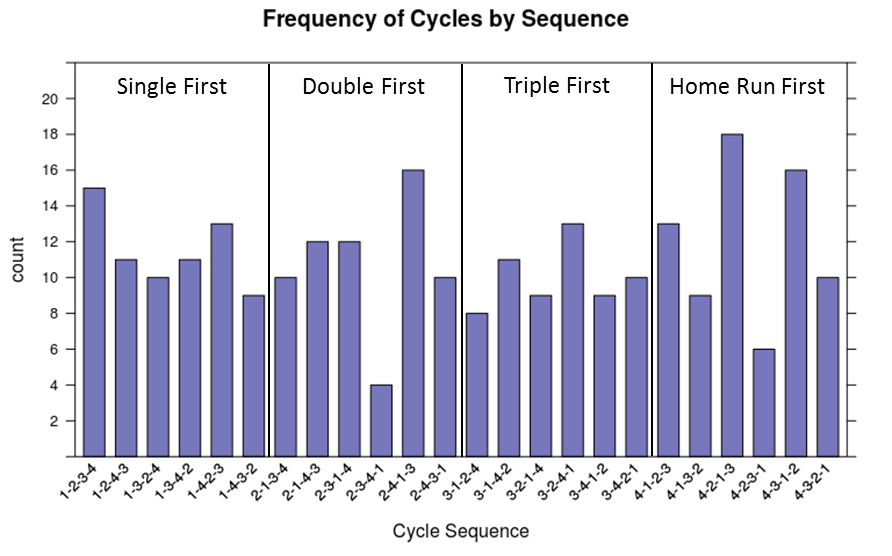
Figure 10: Frequency of cycles by sequence (of 265 known sequences)
Close behind the most frequent sequence are the 2B–HR–1B–3B sequence and HR–3B–1B–2B with 16 occurrences each, followed by the 1B–2B–3B–HR (the natural cycle) with 15 occurrences. The sequence with the fewest counts is the 2B–3B–HR–1B (just four times).
We may never know the sequence of all cycles, as newspaper accounts in the early seasons were vague and unfortunately, play-by-play data are not currently available for almost all games before the 1922 season. For example, we know that New York Giants slugger Sam Leslie hit for the cycle in a game against the Philadelphia Phillies at the Polo Grounds on May 24, 1936, but the play-by-play data are not available. The box score shows his different hits in the Giants’ victory but not the order of occurrence. We do however have every sequence for every cycle since 1937, and we are only missing two sequences since 1921.
Another way of viewing the specific sequences of cycles is to explore how often each type of hit was attained first, second, third, and last. Figure 11 lists the probabilities of each type of hit and when in the order it has occurred.
|
Order the Hit Occurred in the Cycle |
||||
|
Type of Hit |
First |
Second |
Third |
Last |
|
Single |
26.04% |
23.77% |
30.18% |
20.00% |
|
Double |
24.15% |
27.17% |
24.15% |
24.53% |
|
Triple |
22.64% |
23.77% |
22.26% |
31.32% |
|
Home Run |
27.17% |
25.28% |
23.40% |
24.15% |
Figure 11: Probabilities of type of hit in the sequence
Figure 11 shows that of the hits that occur last in the cycle, triples occur most frequently at 31.32%. Nearly as frequent is having the third hit be a single at 30.18%. The most infrequent occurrence is having the last hit of the cycle be a single with 20.00%.
Fans often ask, “Which hit is the hardest to attain?” Perhaps a similar but more quantifiable question is, “Which hit has the highest probability of being the fourth hit in the sequence?” We have seen in Figure 10 that of all known cycles, the triple occurs last most frequently, but one may wonder if this was always the case or if this is a more recent trend. The following charts depict how these probabilities have shifted over the seasons.
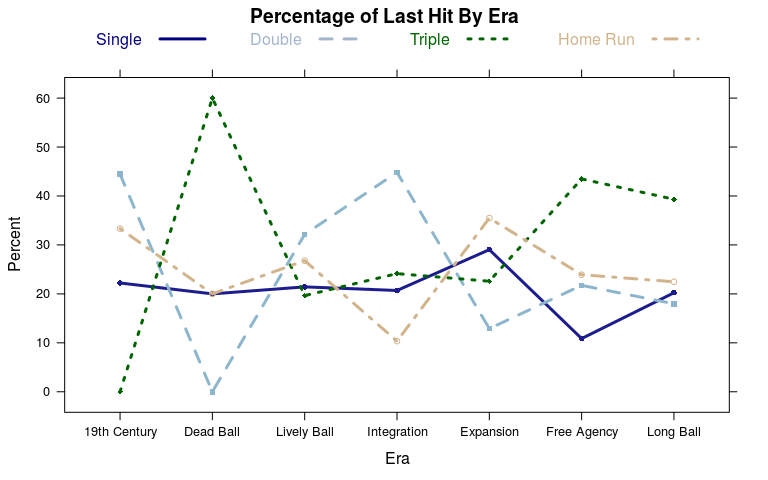
Figure 12: Line graph of the percentage last hit by baseball era
In Figure 12, the Dead Ball Era shows a noticeable spike in percentage of triples being the last hit, and what appears to be a dramatic decline into the Lively Ball Era. With the limited play-by-play information, there are only five known sequences in the Dead Ball Era, two of which were completed by Fred Clarke (of the Pittsburgh Pirates) and in both of his cycles, he hit the triple last.
Another noticeable trend seen in Figure 12 is a steady increase in the percentage of last hits that are triples since the Lively Ball Era; in particular, another relatively large spike in the Free Agency Era. With the Long Ball Era having the largest number of cycles and the Free Agency Era having the third largest number of cycles, all of which we have the full sequence in which the cycle occurred, there seems to be a significant trend.
We acknowledge that Figure 12 can be busy, given that the data span over 140 seasons. As the Free Agency Era begins in the late 1970s, we zoom in on the last five decades in Figure 13. We can see that in all but the 1990s, triples have been the last hit for a larger proportion of the cycles than any other hit (in the 1990s there were eight cycles where the home run was the final hit and seven with the triple as the last hit). If the last of the four hits is viewed by the batter and fans as the “hardest,” then Figure 13 seems to lend credibility that the triple might be the hardest hit to get in accomplishing a cycle.
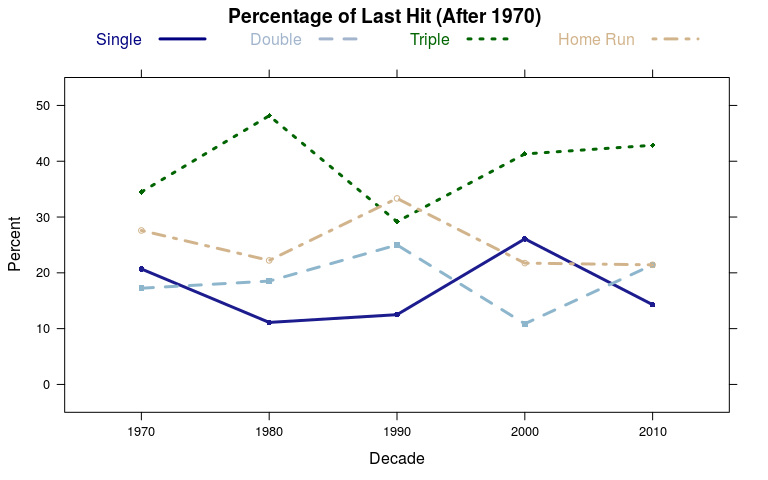
Figure 13: Line graph depicting the percentage of last hit since 1970
If one were to show using probabilities that a certain type of hit (single, double, triple, or home run) is the hardest to attain, one would need to explore the frequency of all hits, and the type of hit that occurred the least would arguably be the hardest to attain. By focusing on cycles, the probabilities we examine are conditional on the fact that we know one of each type of hit occurred. We no longer want to look for the hit that occurs infrequently, but rather explore the order in which the hits take place. It can be argued then that the hits that occur in the first at-bats are perhaps easier to attain than hits that occur last in the sequence. Therefore, if a certain type of hit occurs more often as the last hit in the sequence, it can be viewed as the hardest of the four types of hits.
Statistically speaking, the triple is the last hit significantly more frequently than any other hit in the last five decades (p-value = 0.0002, χ2 = 19.45, degrees of freedom = 3). In other words, if one assumes that all permutations of cycles are equally likely to occur over the last 50 years, the probability one would see the same percentage of triples being hit last as displayed in Figure 13 is 0.0002 (or 0.02%). In both the 1980s and 2010s there have been twice as many triples as the last hit than home runs, the next most frequent last hit. In the 2000s, the frequency of triples as the last hit to complete the cycle were nearly twice that of singles. For the hits to have the same level of difficulty, the trends would hover around 25% for each. We can see in Figure 13 that the percentage of triples being hit last has been far above 25% for the last several decades. There have been 40 instances of a batter hitting for the cycle in the last ten seasons (2008–17). In half of those (20 times), the batter hit the triple last.
We can conclude that, for the last close-to-50 years, triples are most likely to be the final hit which completes the cycle. Our research has studied just the four hits, not taking into account the number of at-bats (how often has it been only four at-bats?) or the number of hits (some batters have had more than four hits in accomplishing the cycle). In those instances, we do not include extra hits of the same number of bases but only recorded which type of hit was first, second, third, or last.
Conclusions
Although the phrase “cycle” is commonplace to describe the rare feat of getting one of each type of hit in a single game, it took nearly five decades for the term to stick and become popular in the national newspaper media. It has been shown that the first use of the word “cycle” occurred in 1921, penned for the accomplishment of George Sisler, the 70th cycle to have occurred in baseball history at that time, with the second occurrence of the word/phrase nearly one decade later. It wasn’t until after the explosion of cycles in the Lively Ball Era that the term found a permanent place in baseball vernacular.
Furthermore, it was shown that not all permutations of cycles are equally likely to occur. In the last five decades, when the sheer number of cycles occurring showed a dramatic increase, the triple is the last hit to attain significantly more often than any other hit.
The data listing all cycles and their known sequence of hits are provided as an online appendix at SABR.org.
MICHAEL HUBER, a Professor of Mathematics at Muhlenberg College, joined SABR in 1996. Dr. Huber’s research interests include studying rare events in baseball, such as hitting for the cycle and pitching a no-hitter. He frequently sponsors undergraduate research involving simulations using baseball data.
ALLISON DAVIDSON is an Assistant Professor of Mathematics at Muhlenberg College. Dr. Davidson’s research interests include applied statistics and probability as well as statistics education. Recent applications include neurological reception in the vision of flies, what makes a popular tweet, and the impact of food waste on college campuses.
Notes
1 https://retrosheet.org/cycles. There are two discrepancies with the Retrosheet list. First, Retrosheet lists Philadelphia Athletics player George Hall as having accomplished the first cycle (June 14, 1876). For a description of that game, see Mike Huber, “June 14, 1876: George Hall gets five hits, but is it a cycle?” https://sabr.org/gamesproj/game/june-14-1876-george-hall-gets-five-hits-it-cycle, November 2017. Different newspapers have varying accounts as to the types of hits achieved by Hall in the game. We do not include Hall’s game as an official cycle. Second, Retrosheet has not yet added a cycle hit by Chicago White Sox player Jose Abreu (September 9, 2017). Therefore, we use 319 as the official number of cycles.
2 As of the end of the 2017 regular season, according to baseball-reference.com. See https://baseball-reference.com/leagues/index.shtml.
3 For a description of that game, see Mike Huber, “May 25, 1882: Buffalo’s Curry Foley completes first cycle in major leagues with grand slam,” posted online at https://sabr.org/gamesproj/game/may-25-1882-buffalos-curry-foley-completes-first-cycle-major-leagues-grand-slam, September 2015.
4 “NetShrine Baseball Timeline,” found online at https://netshrine.com/era.html. Accessed August 2017.
5 Paul Dickson, The Dickson Baseball Dictionary, Third Edition, New York: W.W. Norton & Company (2009), edited by Skip McAfee, under the heading “hit for the cycle” (page 416).
6 Cecilia Tan of the Society for American Baseball Research posted this Washington Post quotation on the SABR-L listserv on November 17, 2003.
7 “High Lights of Mace and Mound In Two Leagues Last Week,” Tennessean (Nashville, Tennessee), August 21, 1921: 12. This information was reported in Herm Krabbenhoft’s article, “Quasi-Cycles: Better Than Cycles?”, Baseball Research Journal, Fall 2017.
8 “Herman Hits Cycle as Robins Slam Reds, 14-4,” Reading Times (Reading, PA), May 19, 1931: 15.
9 Ibid.
10 For a description of that game, see Mike Huber, “June 3, 1932: Lou Gehrig hits four home runs, Tony Lazzeri hits for cycle in Yankees romp,” posted online at https://sabr.org/gamesproj/game/june-3-1932-lou-gehrig-hits-four-home-runs-tony-lazzeri-hits-cycle-yankees-romp, July 2015.
11 Headline in Great Falls Tribune (Great Falls, Montana), July 23, 1932: 8.
12 Headline in Tennessean (Nashville, Tennessee), July 23, 1932: 8.
13 Associated Press article in Great Falls Tribune (Great Falls, Montana), July 23, 1932: 8 and The Tennessean (Nashville, Tennessee), July 23, 1932: 8.
14 This record was tied in 2009 when eight batters hit for the cycle. No season has had more than eight cycles.
15 Reading Times (Reading, PA), August 15, 1933: 10.
16 James C. Isaminger, “Averill Leads Tribal Spurt to Batter A’s,” Philadelphia Inquirer, August 18, 1933: 13.
17 Headline in News-Journal (Mansfield, Ohio), August 18, 1933: 12.
18 “Indians Wallop Athletics, 15 to 4,” Des Moines Register, August 18, 1933: 8.
19 The Sporting News, January 4, 1934: 6.
20 J. Roy Stockton, “Dean Registers 202d Strikeout; Babe Herman Shines at Bat,” St. Louis Post-Dispatch, October 1, 1933: 18.
21 Henry P. Edwards, “High Spots of 1933 in American League,” The Sporting News, January 11, 1934: 2.
22 James C. Isaminger, “Gehrig’s 15th Ends Mack Hope in First and Yankees Romp,” Philadelphia Inquirer, June 11, 1934: 14.
23 The Sporting News, April 18, 1935: 5.
24 J. Roy Stockton, “Medwick Hits Home Run, Triple, Double, and Single,” St. Louis Post-Dispatch, June 30, 1935: 17.
25 “They Go Wild With Bats in Big Hitting Day,” Pittsburgh Post-Gazette, May 25, 1936: 14.
26 W. W. Edgar, “38,200 See Tigers Beat Indians, 4-3, in Season Opener,” Detroit Free Press, April 21, 1937: 1.
27 Daniel M. Daniel, “N.Y. Calls DiMaggio ‘Right-Handed Ruth,’” The Sporting News, July 15, 1937: 2.
28 “Gehrig Hits For Cycle, While DiMaggio and Rolfe Crack Homers–Score Is 14-5,” AP story found in Cincinnati Enquirer, August 2, 1937: 10.
29 Leslie Avery, “DiMaggio Destined to Become One of Game’s Greatest Players,” Lincoln Evening Journal (Lincoln, Nebraska), August 2, 1937: 9.
30 “Gehrig Leads Assault With ‘Cycle’ Hits,” AP story found in Arizona Republic, August 2, 1937: 8.
31 The Sporting News, September 29, 1938: 4.
32 The Sporting News, May 11, 1939: 3.
33 The Sporting News, July 18, 1940: 2.
34 The Sporting News, July 25, 1940: 1.
35 The Sporting News, August 8, 1940: 2.
36 The Sporting News, January 2, 1941: 3.
37 Corey Brock, “Kemp completes first cycle in Padres history,” MLB.com, August 15, 2015. Found online at https://mlb.com/news/matt-kemp-hits-first-padres-cycle/c-143243112.
38 Ibid.


